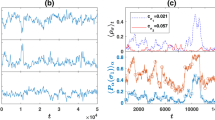Abstract
The evolution of communication requires the co-evolution of two abilities: the ability to send useful signals and the ability to react appropriately to perceived signals. This fact poses two related but distinct problems, which are often mixed up: (1) the phylogenetic problem regarding how can communication evolve if the two traits that are necessary for its emergence are complementary and seem to require each other for providing reproductive advantages; (2) the adaptive problem regarding how can communication systems that do not advantage both signallers and receivers in the same way emerge, given their altruistic character. Here we clarify the distinction, and provide some insights on how these problems can be solved in both real and artificial systems by reporting experiments on the evolution of artificial agents that have to evolve a simple food-call communication system. Our experiments show that (1) the phylogenetic problem can be solved thanks to the presence of producer biases that make agents spontaneously produce useful signals, an idea that is complementary to the well-known “receiver bias” hypothesis found in the biological literature, and (2) the adaptive problem can be solved by having agents communicate preferentially among kin, as predicted by kin selection theory. We discuss these results with respect to both the scientific understanding of the evolution of communication and the design of embodied and communicating artificial agents.
Access this chapter
Tax calculation will be finalised at checkout
Purchases are for personal use only
Preview
Unable to display preview. Download preview PDF.
Similar content being viewed by others
References
Ackley, D. H., & Littman, M. L. (1994). Altruism in the evolution of communication. In R. A. Brooks & P. Maes (Eds.), Artificial life IV: proceedings of the international workshop on the synthesis and simulation of living systems (pp. 40–48). Cambridge: MIT Press.
Arak, A., & Enquist, M. (1995). Conflict, receiver bias and the evolution of signal form. Philosophical Transactions of the Royal Society, Series B, 349, 337–344.
Axelrod, R. (1981). The evolution of cooperation. Science, 211(4489), 1390–1396.
Basolo, A. L. (1995). Phylogenetic evidence for the role of a pre-existing bias in sexual selection. Proceedings of the Royal Society of London B, 259(1356), 307–311.
Beer, R. D. (2003). The dynamics of active categorical perception in an evolved model agent. Adaptive Behavior, 11(4), 209–243.
Brooks, R. A. (1991). Intelligence without representation. Artificial Intelligence Journal, 47, 139–159.
Bullock, S. (1998). A continuous evolutionary simulation model of the attainability of honest signalling equilibria. In C. Adami, R. Belew, H. Kitano, & C. Taylor (Eds.), Proceedings of the sixth international conference on artificial life (pp. 339–348).
Cangelosi, A., & Harnad, S. (2000). The adaptive advantage of symbolic theft over sensorimotor toil: Grounding language in perceptual categories. Evolution of Communication, 4, 117–142.
Cangelosi, A., & Parisi, D. (1998). The emergence of a language in an evolving population of neural networks. Connection Science, 10(2), 83–97.
Cheney, D. L., & Seyfarth, R. M. (1990). How monkeys see the world: inside the mind of another species. Chicago: University of Chicago Press.
Dawkins, R., & Krebs, J. R. (1978). Animal signals: information or manipulation? In J. R. Krebs & N. B. Davies (Eds.), Behavioural ecology: an evolutionary approach (pp. 282–309). Oxford: Blackwell Sci.
Di Paolo, E. (1998). An investigation into the evolution of communication. Adaptive Behavior, 6(2), 285–324.
Di Paolo, E. A. (1999). A little more than kind and less than kin: the unwarranted use of kin selection in spatial models of communication. In D. Floreano, J. Nicoud, & F. Mondada (Eds.), Advances in artificial life. Proceedings of the 5th European conference on artificial life (pp. 504–513). Lausanne: Springer.
Endler, J. A., & Basolo, A. L. (1998). Sensory ecology, receiver biases and sexual selection. Trends in Ecology & Evolution, 13(10), 415–420.
Frisch, K. V. (1967). The dance language and orientation of bees. Cambridge: Harvard University Press.
Grafen, A. (1990). Biological signals as handicaps. Journal of Theoretical Biology, 144, 517–546.
Guilford, T., & Dawkins, M. S. (1991). Receiver psychology and the evolution of animal signals. Animal Behaviour, 42, 1–14.
Hamilton, W. D. (1964). Genetic evolution of social behavior. Journal of Theoretical Biology, 7(1), 1–52.
Harvey, I. (1996). Untimed and misrepresented: connectionism and the computer metaphor. AISB Quarterly, 96, 20–27.
Hauser, M. D. (1996). The evolution of communication. Cambridge: MIT Press.
Hihara, S., Yamada, H., Iriki, A., & Okanoya, K. (2003). Spontaneous vocal differentiation of coo-calls for tools and food in Japanese monkeys. Neuroscience Research, 45, 383–389.
Krebs, J. R., & Dawkins, R. (1984). Animal signals: Mind-reading and manipulation. In J. R. Krebs & N. B. Davies (Eds.), Behavioral ecology: an evolutionary approach (2nd ed.) (pp. 380–402). Oxford: Blackwell Sci. Chap. 15.
Lotem, A., Wagner, R., & Balshine-Earn, S. (1999). The overlooked signaling component in non-signaling behavior. Behavioral Ecology, 10, 209–212.
MacLennan, B., & Burghardt, G. M. (1993). Synthetic ethology and the evolution of cooperative communication. Adaptive Behavior, 2(2), 161–187.
Marocco, D., Cangelosi, A., & Nolfi, S. (2003). The emergence of communication in evolutionary robots. Philosophical Transactions of the Royal Society Series A, Mathematical, Physical and Engineering Sciences, 361(1811), 2397–2421.
Maynard-Smith, J., & Harper, D. G. (2003). Animal signals. London: Oxford University Press.
Mirolli, M., & Parisi, D. (2005). How can we explain the emergence of a language which benefits the hearer but not the speaker? Connection Science, 17(3–4), 325–341.
Mirolli, M., & Parisi, D. (2006). Talking to oneself as a selective pressure for the emergence of language. In A. Cangelosi, A. Smith, & K. Smith (Eds.), The evolution of language: proceedings of the 6th international conference on the evolution of language (pp. 214–221). Singapore: World Scientific.
Mirolli, M., & Parisi, D. (2008). How producer biases can favour the evolution of communication: an analysis of evolutionary dynamics. Adaptive Behavior, 16(1), 27–52.
Mirolli, M., & Parisi, D. (2009). Towards a Vygotskyan cognitive robotics: the role of language as a cognitive tool. New Ideas in Psychology. doi:10.1016/j.newideapsych.2009.07.001, ISSN 0732-118X, http://www.sciencedirect.com/science/article/B6VD4-4X00P73-1/2/5eb2e93d3fc615eea3ec0f637af6fc89
Mitchell, M. (1996). Introduction to genetic algorithms. Cambridge: MIT Press.
Noble, J. (1998). Tough guys don’t dance: intention movements and the evolution of signalling in animal. In R. Pfeifer, B. Blumberg, & H. Kobayashi (Eds.), Proceedings of the fifth international conference on the simulation of adaptive behavior. Cambridge: MIT Press.
Noble, J., Di Paolo, E. A., & Bullock, S. (2001). Adaptive factors in the evolution of signalling systems. In A. Cangelosi & D. Parisi (Eds.), Simulating the evolution of language (pp. 53–78). Heidelberg: Springer.
Oliphant, M. (1996). The dilemma of saussurean communication. Biosystems, 37(1–2), 31–38.
Parisi, D. (1997). An artificial life approach to language. Brain and Language, 59, 121–146.
Proctor, H. C. (1992). Sensory exploitation and the evolution of male mating behaviour: a cladistic test using water mites (acari: Parasitengona). Animal Behaviour, (44), 745–752.
Ryan, M. J. (1990). Sexual selection, sensory systems and sensory exploitation. Oxford Surveys in Evolutionary Biology, 7, 157–195.
Ryan, M. J., & Rand, A. S. (1993). Sexual selection and signal evolution: the ghost of biases past. Philosophical Transactions of the Royal Society of London. Series B, Biological Sciences, 340, 187–195.
Ryan, M. J., Fox, J. H., Wilczynski, W., & Rand, A. S. (1990). Sexual selection for sensory exploitation in the frog physalaemus pustulosus. Nature, 343(6253), 66–67.
Ryan, M. J., Phelps, S. M., & Rand, A. S. (2001). How evolutionary history shapes recognition mechanisms. Trends in Cognitive Sciences, 5(4), 143–148.
Seeley, T. D. (1992). The tremble dance of the honey bee: message and meanings. Behavioral Ecology and Sociobiology, 31, 375–383.
Simon, H. A. (1990). A mechanism for social selection and successful altruism. Science, 250, 1665–1668.
Steels, L. (1996). Emergent adaptive lexicons. In P. Maes, M. Mataric, J. Meyer, J. Pollack, & S. Wilson (Eds.), From animals to animats 4: proceedings of the fourth international conference on simulation of adaptive behavior (pp. 562–567). Cambridge: MIT Press.
Struhsaker, T. T. (1967). Auditory communication among vervet monkeys (cercopithecus aethiops). In S. A. Altmann (Ed.), Social communication among primates. Chicago: University of Chicago Press.
Tinbergen, N. (1952). Derived activities: Their causation, biological significance, origin and emancipation during evolution. Quarterly Review of Biology, 27, 1–32.
Tinbergen, N. (1963). On aims and methods of ethology. Zeitschrift fur Tierpsychologie, 20, 410–433.
Trivers, R. L. (1971). The evolution of reciprocal altruism. Quarterly Review of Biology, 46, 35–57.
Zahavi, A. (1975). Mate selection. A selection for a handicap. Journal of Theoretical Biology, 53, 205–214.
Author information
Authors and Affiliations
Corresponding author
Editor information
Editors and Affiliations
Rights and permissions
Copyright information
© 2010 Springer-Verlag Berlin Heidelberg
About this chapter
Cite this chapter
Mirolli, M., Parisi, D. (2010). Producer Biases and Kin Selection in the Evolution of Communication. In: Nolfi, S., Mirolli, M. (eds) Evolution of Communication and Language in Embodied Agents. Springer, Berlin, Heidelberg. https://doi.org/10.1007/978-3-642-01250-1_9
Download citation
DOI: https://doi.org/10.1007/978-3-642-01250-1_9
Published:
Publisher Name: Springer, Berlin, Heidelberg
Print ISBN: 978-3-642-01249-5
Online ISBN: 978-3-642-01250-1
eBook Packages: Computer ScienceComputer Science (R0)




